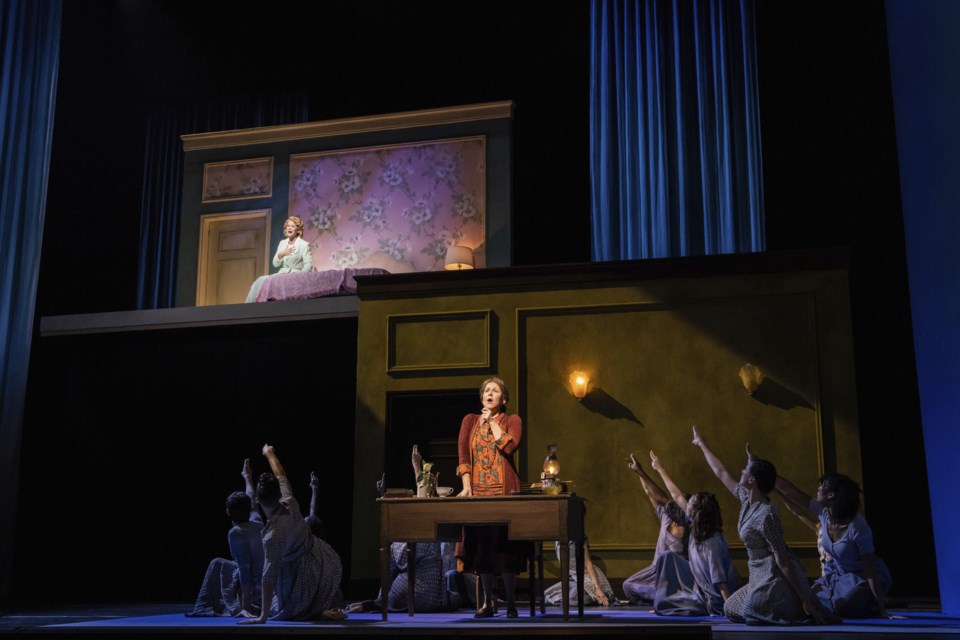NEW YORK (AP) ŌĆö It was a delicious challenge that came as a total surprise.
As choreographer Annie-B Parson tells it, she was walking down a Brooklyn street when her phone rang. It was the general manager of the Metropolitan Opera, Peter Gelb, wondering if sheŌĆÖd be interested in choreographing for the Met.
Parson, based in Brooklyn, founder of the Big Dance Theater and also known for choreographing David ByrneŌĆÖs joyous ŌĆ£American UtopiaŌĆØ on Broadway, had never done an opera and acknowledges she knew little about the art form.
But of course she was interested. It was the MetŌĆÖs buzzy, commissioned production of ŌĆ£The Hours,ŌĆØ about the interior lives of three women connected ŌĆö across generations and an ocean ŌĆö by Virginia Woolf and her writings (one of them Woolf herself). Parson would be the only woman on the creative team.
And so one of her first decisions when she came on board was that all dancers should be female, or female-identifying.
ŌĆ£We auditioned probably 150 people,ŌĆØ she said in an interview, for a dance cast of 13. ŌĆ£And as the only female creative team member in a piece about an extremely radical feminist voice, it was very important to me to bring that feminism to the stage.ŌĆØ
ŌĆ£ThatŌĆÖs a personal statement on my part," she added. ŌĆ£None of the men can do that ... Nobody knows what itŌĆÖs like to be anything unless theyŌĆÖre it, right?ŌĆØ
The opera, by composer Kevin Puts and librettist Greg Pierce, is based on Michael CunninghamŌĆÖs Pulitzer Prize-winning 1998 novel (later adapted into the film starring Meryl Streep, Julianne Moore and Nicole Kidman, who won an Oscar) about three women connected specifically by WoolfŌĆÖs 1925 novel ŌĆ£Mrs. Dalloway.ŌĆØ
It stars a powerhouse trio of Ren├®e Fleming as Clarissa Vaughan; Kelli OŌĆÖHara as Laura Brown; and Joyce DiDonato, as Woolf herself. Directed by Phelim McDermott, it runs through Dec. 15, including a Dec. 10 matinee simulcast to movie theaters worldwide.
Gelb says he reached out to Parson because heŌĆÖd been impressed by her work in ŌĆ£American Utopia,ŌĆØ and thought sheŌĆÖd be a great fit with McDermott: ŌĆ£Part of my job as general manager is to be a creative matchmaker."
He said in an interview that he feels Parson's contribution has been to amplify and richen the story of ŌĆ£The HoursŌĆØ for everyone in the vast, 3,800-seat theater, ŌĆ£as far back as the last row of the Family Circle.ŌĆØ (And on a recent evening, it looked like every one of those seats were taken.)
The opera unfolds over one day in three different places and eras. Woolf is attempting to write, and feeling suffocated in a country home outside London in 1923; Brown is an unhappy housewife and mother in 1949 Los Angeles; and Clarissa Vaughn is an editor arranging a party ŌĆö organizing flowers and food ŌĆō for her dear, ailing friend Richard, a novelist who has AIDS, in late 20th-century New York.
Parson says she was acutely aware of the challenge of illustrating the interior lives of the women, but did not set out to psychoanalyze them in movement. ŌĆ£I feel like if I had tried to do that, it wouldn't have worked,ŌĆØ she says. She wanted to get there, but in a different way.
So, in a process she modestly describes as more ŌĆ£mundane,ŌĆØ the choreographer focused on actions, not thoughts.
ŌĆ£I donŌĆÖt want to describe someoneŌĆÖs unconscious,ŌĆØ she says. "So for Virginia Woolf, I looked at, what does she DO? She writes, she reads. I worked on those actions. What does Clarissa do? She buys flowers. What does Laura do? She bakes. She takes pills.ŌĆØ
Another example: When Clarissa's ailing friend RichardŌĆÖs apartment rolls onto the stage, ParsonŌĆÖs dancers are hanging off the platform in what looks like a chilling metaphor for illness. Parson agrees, but says her aim was actually, ŌĆ£thereŌĆÖs this platform and itŌĆÖs moving, and how can I animate it?ŌĆØ
The choreographer spoke from Lyon, France, where she is now working on her second opera. She said that even though ŌĆ£The HoursŌĆØ was her first, it wasn't as difficult as it sounds to adjust her craft.
ŌĆ£I have worked so much with musicians, great musicians," she says, like Byrne and many others. ŌĆ£So thinking about how a show rolls out and how to choreograph to music so itŌĆÖs supportive and at the same time has its own life ... it didnŌĆÖt seem that different.ŌĆØ
It was, however a dream to have so much time to rehearse, and to have the operaŌĆÖs resources behind her. She was thrilled, for example, that when she rehearsed by herself, she had a pianist. ŌĆ£I mean, IŌĆÖve never had that experience before,ŌĆØ she said with a laugh. ŌĆ£IŌĆÖm always listening on my iPhone to music when IŌĆÖm working on my own. Everything about making dance at the Met is heightened and supported. I can't tell you how much fun it was."
An added bonus for Parson, who hadn't read Woolf since working on a play of hers more than a decade ago, was getting to read her again, especially her diaries and ŌĆ£A Room of One's Own" ŌĆö and especially now, in 2022.
ŌĆ£Her writing is so profound,ŌĆØ Parson said. ŌĆ£And the worldŌĆÖs changed a lot in terms of gender and feminism. So she reads really, really well right now. It was really exciting. I actually want to cry right now, IŌĆÖm so moved by thinking about her."
Jocelyn Noveck, The Associated Press




